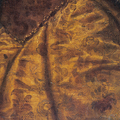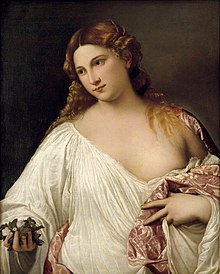Girl with fruit bowl

|
| Girl with fruit bowl |
|---|
| Titian , around 1555 |
| Oil on canvas |
| 106.2 x 84.8 cm |
| Gemäldegalerie Berlin |
Girl with a Fruit Peel is a painting exhibited in the Berlin Gemäldegalerie . It is dated around 1555 and ascribed to Titian . There are several versions of this painting.
Material and technology
Girl with a fruit bowl is a painting painted with oil paints on canvas and belongs to the genre of panel painting . Its size is 106.2 × 84.8 cm.
conservation
The painting is slightly trimmed on the right and was later supplemented by a 4.2 cm wide, attached strip.
description
As a so-called half -length portrait , the girl in this rectangular upright format turns her head clearly back to the viewer, while with both hands she holds up a silver bowl filled with fruits (lemons, apples) and flowers ( roses ) unusually high. This gives your body a backward sloping posture, which accentuates the generously cut back and a frilled undergarment. Both merge into a form-flattering stole . The curly updo is crowned by a diadem and the neck is surrounded by a pearl necklace with an earring hanging over it . The girl is wearing expensive, contemporary clothes and accessories . Especially her delicate face and the magnificent pearl jewelry are painted in fine detail. In contrast, the contours of the gold embroidered dress with a flared skirt, tight corset and slit page sleeves dissolve in some areas. Titian showed a similar approach in the portrait of Clarissa Strozzi from 1542, in which jewelry and clothing were also structured differently.
In combination with the girl's moving posture, this surface treatment creates a certain liveliness, as if she had just turned around at that moment. The brown and gold tones of the dress and hair create additional solemnity, which is enhanced by the jewelry and the bright accents. A dark red, heavy curtain in the background of the left half of the picture reveals a view of a dark mountainous landscape towards which the girl seems to be walking.
interpretation
In older interpretations it was assumed that the girl depicted is a portrait of Titian's daughter Lavinia. It appears in some of his paintings where a similarity is obvious. For a portrait of Lavinia, a look at Titian's biography can also be used. If the date of creation of the painting around 1555 is correct, then this painting was created one year after Lavinia married the nobleman Cornelio Sarcinelli di Serravalle. The costly clothing and jewelry could thus indicate the lavish dowry Lavinia possessed due to her father's handsome income. The addition of the fruit and rose attributes would also mark the prosperity, but also stand for the fertility and beauty of his daughter. In general, the fruit is a symbol of maturity and complete development in the fine arts.
In this context, the portrait of the lady in white can also be used, which was also interpreted as an alleged portrait of Lavinia and was made in the same year as the girl with a fruit peel . What is striking here is the entire clothing in white, in which Lavinia can be seen again as a newlywed.
However, Tizian seems to have used Lavinia only as a model in Girl with Fruit Peel , in order to use it in an idealized form for another subject. No portrait in the strict sense is shown here. The portrayed remains unknown, but has clearly narrative properties.
Comparable to Titian's Flora in the Uffizi Gallery in Florence , which depicts an allegory of spring, Girl with a Fruit Bowl could in turn depict Pomona , the Roman goddess of the autumn fruit blessing. After that she would represent the allegory of fertility. An indication of this is provided by Nicolò Stoppio, the Fugger's art agent, who wrote to Jacop Fugger in 1568 and 1569 that Jacopo Strada , the painter, art dealer and agent of Emperors Maximilian II and Rudolf II , had received a Dea Pomona from Titian. This picture appeared again in the inventories of the imperial collection in Prague (1619, 1621), captured by the Swedes and was last listed in the inventory of Queen Christine of Sweden (1656). According to Erwin Panofsky (1969) it could possibly be identified with the Berlin picture.
Dating
Various later versions of Titian's hand are said to exist of the Berlin picture, for example in Madrid in the Museo del Prado as Salome . According to this, it is assumed that all other versions were made later than the Berlin picture, i.e. after 1555 and that the Berlin picture thus represents the prototype. On the other hand, due to the dating of 1550 to 1555, the Museo del Prado determines the painting of Salome as the original version. In the picture, the head of John the Baptist is on a tray, while here and in other variants painted by Titian and his workshop the figure bears fruit and is then derived from the Madrid painting. Also, Sotheby's , which manages a later version of this composition with the representation of Pomona from the collection of George Encil, assumes that this draft deduce from Titian's Salome.
Frames
- Further, varying versions
- Salome with the Baptist's head on a silver bowl , 1550–1555, Madrid, Museo del Prado.
- Girl with a jewelry box on a silver bowl , London, Mrs. Abbott Collection.
- Girl with fruit bowl in sleeveless robe , with different facial features and hair ornament, Pomona, 1562–1563, Montreal, formerly the George Encil Collection, Montreal.
- Girl with a fruit bowl (two melons) in antique-style robes and hair ornaments , apparently as Pomona, 1621–1624, handed down in a drawing by van Dyck and an engraving by Wenceslaus Hollar.
literature
- Girl with fruit bowl. Around 1555. In: Gemäldegalerie Berlin. Catalog of the paintings from the 13th to 18th centuries. Century. Gemäldegalerie Berlin, State Museums of Prussian Cultural Heritage, Berlin-Dahlem 1975.
- Erwin Panofsky : Problems in Titian. Mostly iconographic. New York Univ. Press, New York 1969.
Web links
- Girl with a fruit bowl in the online database of the Staatliche Museen zu Berlin
Individual evidence
- ↑ Girl with a fruit bowl. Around 1555 . In: Gemäldegalerie Berlin. Catalog of the paintings from the 13th to 18th centuries. Gemäldegalerie Berlin, Staatliche Museen Preussischer Kulturbesitz, Berlin-Dahlem 1975, ISBN 3-7861-6196-8 , p. 437-438, here p. 438 .
- ^ Erwin Panofsky: Problems in Titian. Mostly iconographic . New York Univ. Press, New York 1969, ISBN 0-7148-1325-7 .
- ↑ SMB digital | Girl with fruit bowl. Retrieved July 14, 2020 .
- ^ Salome - The Collection - Museo Nacional del Prado. Retrieved July 14, 2020 .
- ↑ PROPERTY FROM A PRIVATE COLLECTION Follower of Tiziano Vecellio, called Titian POMONA. Retrieved July 14, 2020 .
- ↑ Girl with a fruit bowl. Around 1555 . In: Gemäldegalerie Berlin. Catalog of the paintings from the 13th to 18th centuries . Gemäldegalerie Berlin, State Museums of Prussian Cultural Heritage, Berlin-Dahlem 1975.







